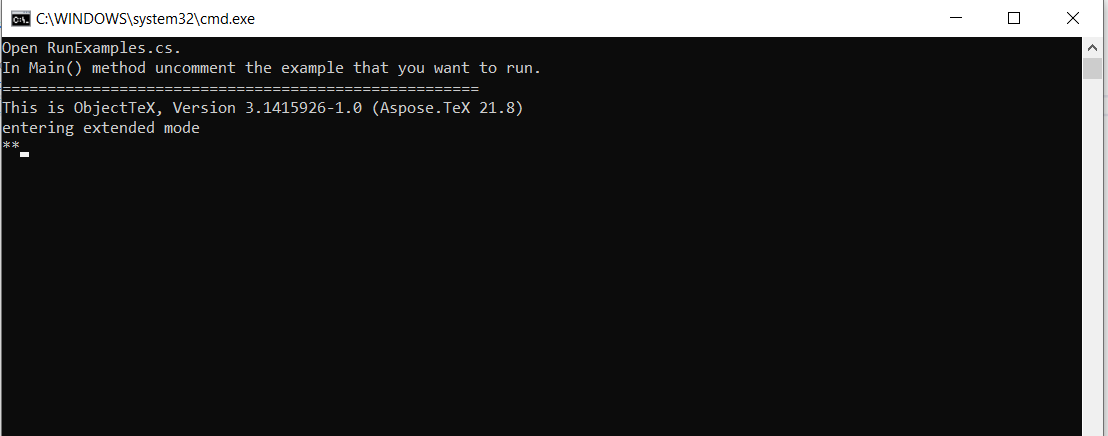Outras maneiras de fornecer o principal arquivo de entrada tex principal | .NET
Fornecendo o arquivo de entrada principal para o mecanismo TEX como um fluxo
Até este ponto, sabíamos apenas como passar o
arquivo de entrada principal para o mecanismo TEX como nome de arquivo, totalmente especificado ou de curta forma, seja com uma extensão ou sem ele. Mas há outro
construtor da classe texjob, que leva um fluxo como o primeiro argumento. Isso é conveniente se, por algum motivo, tivermos o arquivo de entrada principal em um formulário que não seja um arquivo no sistema de arquivos de disco. Veja como pode ser implementado:
1// Stream input with LaTeX document and XPS output
2
3// Create conversion options for Object LaTeX format upon Object TeX engine extension.
4TeXOptions options = TeXOptions.ConsoleAppOptions(TeXConfig.ObjectLaTeX);
5
6// Specify a file system working directory for the output.
7options.OutputWorkingDirectory = new OutputFileSystemDirectory(OutputDir);
8
9// Specify the console as the output terminal.
10options.TerminalOut = new OutputConsoleTerminal();
11
12// Define the saving options.
13options.SaveOptions = new XpsSaveOptions();
14
15// Create the XPS device.
16XpsDevice device = new XpsDevice();
17
18// Run the job with LaTeX document from memory stream.
19TeXJob job = new TeXJob(new MemoryStream(Encoding.ASCII.GetBytes(
20 @"\documentclass{article} \begin{document} Hello, World! \end{document}")),
21 device, options);
22job.Run();
23
24// For further output to look fine.
25options.TerminalOut.Writer.WriteLine();Observe que todos os arquivos de saída terão o nome texput. Isso porque o motor não pode obter nenhum outro nome em nenhum lugar. Texput é o nome da tarefa padrão. Aqui e aqui são detalhes sobre nomes de trabalho.
Entrando no principal arquivo de entrada tex do terminal
Há ainda outro
construtor da classe texjob, que não nos permite especificar a entrada. Então, o que é um trabalho tão tex que vai processar, você pode se perguntar? Desta vez, precisaremos de um terminal de entrada. O mecanismo TEX nos pedirá para inserir o nome do arquivo no terminal.
Aqui está o código:
1// Enter main TeX input file from the terminal (interactive)
2
3// Create conversion options for default ObjectTeX format upon ObjectTeX engine extension.
4TeXOptions options = TeXOptions.ConsoleAppOptions(TeXConfig.ObjectTeX());
5
6// Specify a file system working directory for the input.
7options.InputWorkingDirectory = new InputFileSystemDirectory(DataDir);
8
9// Specify a file system working directory for the output.
10options.OutputWorkingDirectory = new OutputFileSystemDirectory(OutputDir);
11
12// Specify the console as the output terminal.
13options.TerminalOut = new OutputConsoleTerminal();
14
15// Define the saving options.
16options.SaveOptions = new XpsSaveOptions();
17
18// Run the job. The TeX engine will ask to enter the file name from the terminal.
19// Note: This is an interactive example. In production, you would typically
20// provide input via TerminalIn property or use one of the other input methods.
21TeXJob job = new TeXJob(new XpsDevice(), options);
22job.Run();
23
24// For further output to look fine.
25options.TerminalOut.Writer.WriteLine();Assim que é executado, o motor gruda, esperando que insira o nome do arquivo (com ou sem um caminho, com ou sem uma extensão):

E é assim que ficaria no terminal de saída, que é o console:
1This is ObjectTeX, Version 3.1415926-1.0 (Aspose.TeX 21.8)
2entering extended mode
3**<path_to_the_file>/hello-world.ltx
4(<path_to_the_file>/hello-world.ltx
5LaTeX2e <2011/06/27>
6(article.cls
7Document Class: article 2007/10/19 v1.4h Standard LaTeX document class
8(size10.clo))
9No file hello-world.aux.
10[1]
11(<output_directory>\hello-world.aux) )
12Output written on hello-world.xps (1 page).
13Transcript written on hello-world.log.